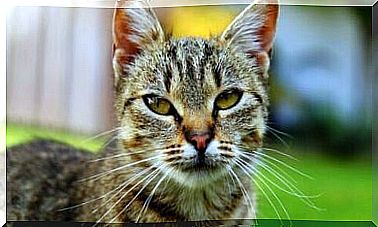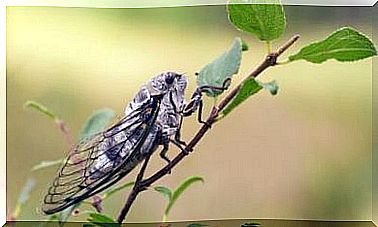Five Nectar-sucking Birds You Might Not Know About
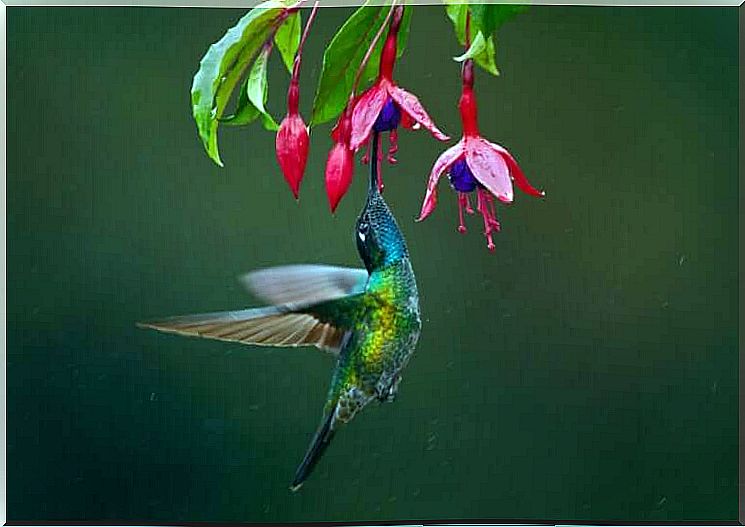
In tropical and temperate regions of the planet, there are many nectar-sucking or nectarivorous birds. Some of the most representative birds of this group are the solar birds (family Nectariniidae ) in Africa and the honey-eating birds (family Meliphagidae) in Australia.
In the neotropical region, or tropical region of the American continent, nectarivory is restricted to birds of the Trochilidae family , also known as hummingbirds or hummingbirds. Within this family are registered about 300 different species.
However, there are references to other species not belonging to this family that also seem to consume nectar. We recommend that you keep reading to learn more about nectar-sucking birds!
What is nectar?
First, to understand the way of life of these curious birds, you need to know what nectar is and why it is so nutritious for these animals. However, it is important to emphasize that no bird can depend exclusively on nectar, since it lacks several essential amino acids.
Nectar is a diluted product and composed mainly of sugar, mainly sucrose. Sometimes it also contains polysaccharides, amino acids and lipids. It is used by nectar-producing plants exclusively as a strategy to attract pollinators.
Plants pollinated by birds often have red flowers (the color birds see best) and are odorless. When the bird approaches to pick up the nectar, it is covered by pollen that it can deposit on the next flower it visits. In this way, it promotes plant pollination.
Fun facts about nectar-sucking birds
As expected, nectar-sucking birds were designed to consume this substance as well as digest it. In addition, they also need to ingest small amounts of insects to supplement their diet. Feeding exclusively on nectar produces very serious deficiencies in birds.
- Necta-eating birds have long, narrow beaks, some slightly curved downward.
- The tongue is also usually very long, with bumps of different nature that increase the surface area and facilitate the extraction of nectar.
- The digestive system of these birds is very short. In addition, gizzards (a highly developed muscular part of the stomach in granivorous birds) are small and sparsely muscled.
- They do not have the typical intestinal cecum of birds.
- Nectar is quickly digested and produces a lot of urine. To prevent electrolyte loss overnight, some nectarivorous birds disrupt their kidney function.
- To get the nutrients that nectar doesn’t provide, these birds spend part of their time looking for soft-bodied arthropods.
- Nectar-sucking bird chicks have a diet based on arthropods that are exchanged for nectar as they grow.
Bird species that consume nectar
Next, we’ll show you some of the most spectacular nectar-sucking birds, as well as some fun facts about their origins or ways of life.
Malachite hummingbird
In Southeast Africa, you can find one of the most beautiful nectar-sucking birds, the malachite hummingbird ( famous Nectarinia ). It belongs to the group of solar birds that, unlike hummingbirds , land on the plant to eat.
During the breeding season, the male malachite hummingbird acquires a very bright bluish green color under the sun’s rays. In addition, two of its tail feathers reach up to 10 centimeters. It feeds mainly on nectar, but it also hunts insects.
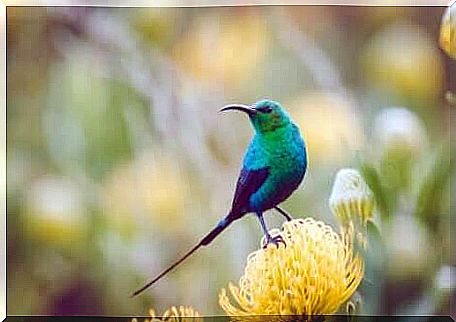
Yellow-bellied hummingbird
The yellow-bellied hummingbird ( Cinnyris venustus) is another solar bird of the Nectariniidae family . It is with its bright yellow chest and the rest of its blue body, which changes color in the sunlight, that the male yellow-bellied hummingbird attracts females. In comparison to them, they have a more discreet coloration, although they keep the chest yellow.
These birds are specialists in building nests, which are suspended from the branches of trees. Like other nectar-sucking birds, they increase insect consumption during the breeding season.
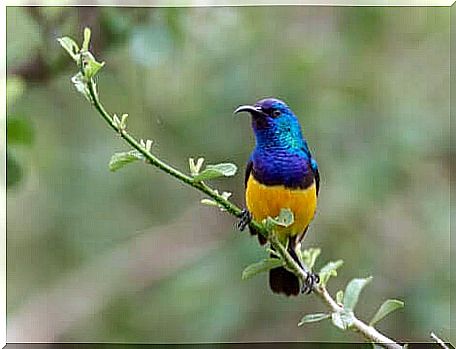
white-eyed honeydew
The white-eyed honeydew ( Phylidonyris novaehollandiae) is an endemic bird to southern Australia. Males and females are very similar to each other. They have a black body with white stripes. The iris is also white. Some of the wing feathers are yellow.
These birds usually live in large groups to avoid predation, although the rearing of the chicks is done by monogamous couples. They are not strict nectar-sucking birds as they also eat arthropods such as crickets and spiders. In addition, they also consume the sugar secreted by some psyllid insects.
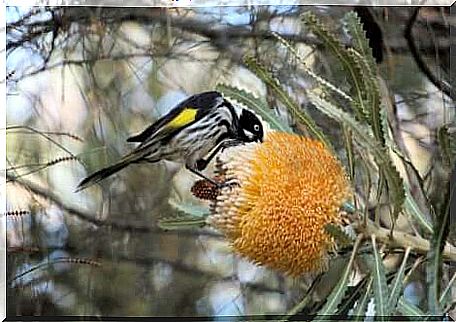
One of the strangest nectar-sucking birds: Philemon yorki
If we looked only at the general physical characteristics of nectar-sucking birds, Philemon yorki would not be included. It inhabits the rainforests off the coast of Queensland, Australia.
It is not possible to say that Philemon yorki is a beautiful bird. In fact, its head is practically devoid of feathers, which leaves its black skin exposed. The rest of the body is covered in light brown plumage.
The beak is wider than that of other species of nectarivorous birds and has a bulge that probably plays a role when courting.
Like the other birds in this group, it feeds mainly on the nectar of flowers. Since they do not have feathers on their face, they maintain greater hygiene and prevent the product from sticking to their feathers.
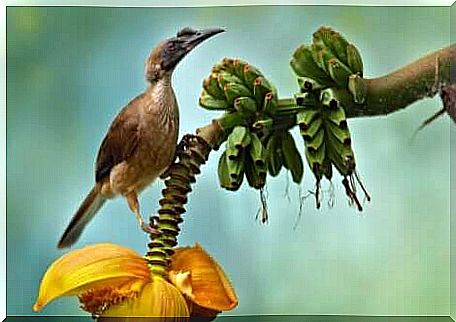
phaethornis guy
The guy Phaethornis belongs to a subfamily of the family Trochilidae, which belong to the hummingbirds. What makes this group different is the fact that they all have a particularly curved beak, glued-up fingers and especially long tail feathers.
More specifically, Phaethornis guy lives in the rainforests of Colombia, Costa Rica, Ecuador, Panama, Peru and Venezuela. The species is distributed at high altitudes, between 800 and 2000 meters.
These birds have a green hue in their entire body plumage. Like hummingbirds, the Phaethornis guy maintains a steady flight while sucking nectar from flowers.
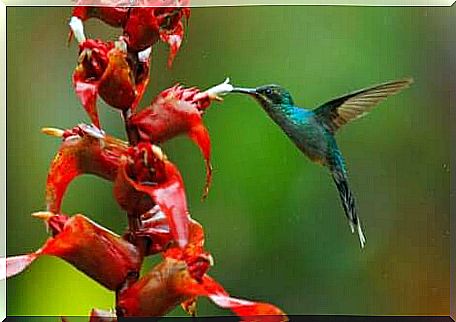
The conservation of nectar-sucking birds
In most cases, the conservation status of many of the nectar-eating species is unknown. Generally, they are very elusive, fast and shy animals.
However, the constant destruction of the environment has harmed their populations. Other significant threats to these birds are habitat fragmentation, the transformation of forests into plantations, road construction and illegal logging.
It is important to know that many of these birds evolved along with specific plant species. So if they disappear, the birds will have nowhere to get the nectar.

